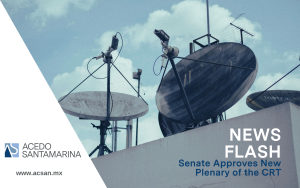On April 1, 2025, the Chamber of Deputies approved, both in general and in particular, a landmark reform regarding public procurement in Mexico: the replacement of the CompraNet system, which had been in place since 1996, with the new Digital Public Procurement Platform. This measure addresses the need to modernize the government’s procurement processes for goods and services, optimize the oversight of public spending, and strengthen transparency and accountability mechanisms.
CompraNet was created as a tool aimed at making public procurement processes in Mexico more transparent and centralized. Since its inception, its goal was to provide a clear mechanism for publishing tenders, receiving proposals, and awarding contracts in a transparent and accessible manner. Over the years, CompraNet became a key tool for transparency, anti-corruption efforts, and accountability.
However, despite the progress made, the platform had operational shortcomings that limited its effectiveness. The main limitations included performance and stability issues, user-unfriendly interfaces, lack of technological updates, and insufficient capacity for preventing and detecting irregularities in real-time.
Objectives and Changes in the New Digital Platform
One of the most significant changes is the full automation and digital modernization of the system. With this measure, the aim is to eliminate manual processes that slowed down the management of tenders and awards, reducing waiting times and increasing operational efficiency.
Another significant change is the reduction in direct awards. Since 2012, this mechanism has accounted for an average of 8 out of every 10 contracts, reflecting an abuse of this modality during the past administrations (National Institute of Statistics and Geography [INEGI], 2024). This measure aims to foster open and transparent competition, limiting autonomy in the allocation of public resources and promoting greater participation from suppliers in public tenders.
Finally, the oversight by the Secretariat of Anticorruption and Good Government (SABG) represents a substantial change in the regulatory framework for public procurement. This body will be responsible for monitoring compliance with legal provisions, ensuring the proper implementation of the new guidelines.
Impact on the Public Sector
The transition to the Digital Public Procurement Platform poses a series of challenges for both the public administration and the actors involved in government procurement processes. Among the main challenges is the complexity of the administrative transition, which will require a restructuring of internal procedures within public institutions. This will involve significant investments in technology, digital infrastructure, staff training, and adjustments to administrative processes, resulting in a substantial short-term financial outlay.
One of the most concerning aspects of the new Digital Public Procurement Platform is the lack of transparency in strategic contracts, particularly those related to the Armed Forces. The decision to exclude these contracts from public access has raised concerns, as it prevents citizens and oversight authorities from knowing how resources are allocated and used in a sector that handles multimillion-dollar budgets. This lack of visibility creates the risk of opacity, which hinders proper oversight and monitoring of how public funds are managed.
Additionally, this measure could conflict with the General Law on Transparency and Access to Public Information (LGTAIP), which establishes the principle of maximum publicity. This principle guarantees that all public information should be accessible to citizens without the need to justify their interest. Although the law provides exceptions for national security reasons, these must be applied in a justified and proportional manner. A blanket exclusion of all defense-related contracts without specific and detailed justification could be considered an undue restriction on the right to access information, violating the current legal framework.
Impact on the Private Sector and Business
For businesses and the private sector, the implementation of the new Digital Public Procurement Platform entails a series of significant adjustments that will affect both their operational capacity and commercial strategy. Large companies will be able to leverage automation and digitalization to optimize their operational processes, enhancing their competitiveness in a more regulated and efficient environment. In contrast, small and medium-sized enterprises (SMEs) will have access to public tenders but will face challenges in technological adaptation and compliance with new regulatory demands.
Furthermore, the introduction of competitive dialogue and active negotiation will alter the landscape of public procurement, leading to greater complexity in commercial and legal strategies.
Opinions and Analysis
The implementation of the Digital Public Procurement Platform has generated divided opinions among experts and analysts. From a positive perspective, specialists such as Eduardo Bohórquez, Director of Transparencia Mexicana, A.C., highlight that the digitalization of processes can improve competition, transparency, and administrative efficiency, significantly reducing opportunities for corruption. He argues that this change represents an opportunity to transform public management into a more open and accessible system for citizens.
However, from a critical perspective, some experts warn that the exclusion of certain strategic contracts, particularly in key sectors such as defense and national security, could lead to increased governmental discretion, limiting transparency in certain areas. They emphasize that, although national security may justify the reservation of certain data, the lack of oversight mechanisms could undermine public trust in the management of critical resources.
The transition from CompraNet to the Digital Public Procurement Platform marks a crucial step toward modernizing the Mexican government’s administrative processes, but it is not without challenges and risks that must be carefully managed. While the implementation of the new platform promises significant improvements in transparency, competitiveness, and administrative efficiency, it is necessary to address certain aspects that could jeopardize its objectives, especially if adequate oversight mechanisms are not put in place.
Angélica Remusat





